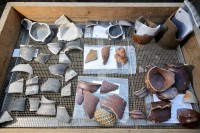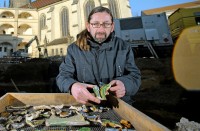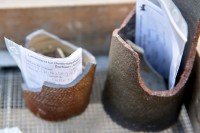 Single-use paper or plastic cups are products of modern consumer culture, cheap, convenient, plentiful and easily discarded. You never have to worry about cleaning them or potential damage to wedding registry china or beloved “#1 Dad” mugs. In the 15th century there were no red Solo cups to fill at the keg line, but that didn’t mean some people couldn’t enjoy the convenience of not having to clean their drinkware or worry that a vessel might slip through drunken fingers to its untimely demise. They just had to be rich and like to show it.
Single-use paper or plastic cups are products of modern consumer culture, cheap, convenient, plentiful and easily discarded. You never have to worry about cleaning them or potential damage to wedding registry china or beloved “#1 Dad” mugs. In the 15th century there were no red Solo cups to fill at the keg line, but that didn’t mean some people couldn’t enjoy the convenience of not having to clean their drinkware or worry that a vessel might slip through drunken fingers to its untimely demise. They just had to be rich and like to show it.
Wittenberg castle, historic residence of the Electors of Saxony, has been undergoing an archaeological excavation since November in advance of the installation of a new sewage pipeline. The team has unearthed the remains of a ring wall encircling the castle site and courtyard pavers from the first castle built by the House of Ascania which ruled the Electorate of Saxony until the branch of the family died out in 1422. After that, the Duchy of Saxony passed to the House of Wettin. The third Elector from the Wettin dynasty, Frederick III, built the current castle on the site of the old Ascanian castle in 1480.
Multi-colored oven tiles decorated with secular and Biblical motifs found during the excavation date to Frederick’s time. They are very rare surviving examples of the original fixtures of the electoral castle. Ovens with such fancy tiles were hugely expensive, the kind of equipment found only in the grand homes of high-ranking aristocrats and ecclesiastical authorities. Martin Luther, who in 1517 famously nailed his 95 Theses to the door of the Castle Church Frederick had built, was known to have owned one of these luxury tiled ovens. It had to have been a gift from someone very wealthy and powerful.
 But it’s the fragments from thousands of porcelain cups found in the castle courtyard that captures the 15th century Electors of Saxony’s version of conspicuous consumption. The cups all date to the 15th century. They are decorated in a variety of patterns, styles and colors. Some have elaborate scrollwork or masks, some are smooth. There are fragments of bright green and yellow, and in neutral shades of brown, grey and ochre red. Except for having been smashed to bits, they are brand new. Archaeologists believe they were used only one time. Once the beverage was quaffed, the imbiber tossed his cup was over his shoulder. It shattered on the courtyard floor and servants quickly supplied the guest with a new filled cup.
But it’s the fragments from thousands of porcelain cups found in the castle courtyard that captures the 15th century Electors of Saxony’s version of conspicuous consumption. The cups all date to the 15th century. They are decorated in a variety of patterns, styles and colors. Some have elaborate scrollwork or masks, some are smooth. There are fragments of bright green and yellow, and in neutral shades of brown, grey and ochre red. Except for having been smashed to bits, they are brand new. Archaeologists believe they were used only one time. Once the beverage was quaffed, the imbiber tossed his cup was over his shoulder. It shattered on the courtyard floor and servants quickly supplied the guest with a new filled cup.
“We found entire layers of cups and animal bones. They ate a lot of wild meat, especially venison,” Holger Rode, the archaeologist in charge of the dig in the castle’s courtyard in Wittenberg, told German news service dpa. “The parties took place in the summer here in the courtyard. The cups were simply thrown away. That’s equivalent to paper cups today.”
Except that porcelain mugs decorated with roll stamps and mask designs likely provided a more luxurious drinking experience. Disposable dishes were a sign of great wealth at the time and only the nobility used them at the castle.
 This massive porcelain cup graveyard is unique to the castle site. Nothing like it has been found in the city of Wittenberg itself. In fact, very few individual cups from this period have been found at all, nevermind broken to pieces in huge quantities. Archaeologists think large numbers of cups were made to order before each feast to supply guests with single-use porcelain to showcase the host’s devil-may-care wealth.
This massive porcelain cup graveyard is unique to the castle site. Nothing like it has been found in the city of Wittenberg itself. In fact, very few individual cups from this period have been found at all, nevermind broken to pieces in huge quantities. Archaeologists think large numbers of cups were made to order before each feast to supply guests with single-use porcelain to showcase the host’s devil-may-care wealth.